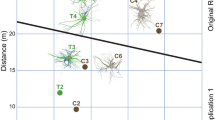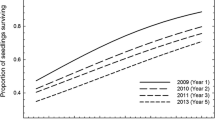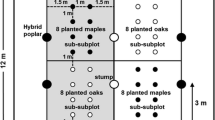Abstract
To provide an objective approach for comparing various planting methods likely to differ in cost, seedling performance, and cost efficiency, loblolly pine (Pinus taeda L.) seedlings were dug-hole or slit planted with either straight, deformed, or pruned taproots, and planting rate (seconds per seedling) and three-year survival and growth of seedlings were measured. The per-hectare cost of dug-hole planting seedlings to ensure straight taproots ($273) was over five times that of slit planting seedlings with intentionally deformed or pruned taproots ($50). Although third-year pine survival did not differ significantly among treatments (74% to 87%), yield index was 58% higher for seedlings dug-hole planted with straight taproots (1152 dm3 stem volume/ha) versus that for seedlings slit planted with deformed or pruned taproots (730 dm3/ha). Third-year cost efficiency (yield index ÷ planting cost) of slit planted seedlings with deformed or pruned taproots (11.7 dm3/$) was over three times that of dug-hole planted seedlings with straight taproots (3.5 dm3/$). These short-term results suggest that the higher values of yield index resulting from straight-root planting do not justify its considerably greater cost.
Similar content being viewed by others
References
Barnett, J. P. and Baker, J. B. 1991. Regeneration methods, pp. 35–50. In: Duryea, M. L. and Dougherty, P. M. (Eds) Forest Regeneration Manual. Kluwer Academic Publishers, Dordrecht, The Netherlands.
Brissette, J. C. and Barnett, J. P. 1989. Depth of planting and J-rooting affect loblolly pine seedlings under stress conditions, pp. 169–175. In: Proc. Fifth Bien. South. Silv. Res. Conf., 1–3 Nov. 1988, Memphis, TN.
Britt, J. R., Mitchell, R. J., Zutter, B. R., South, D. B., Gjerstad, D. H. and Dickson, J. F. 1991. The influence of herbaceous weed control and seedling diameter on six years of loblolly pine growth - a classical growth analysis approach. For. Sci. 37: 655–668.
Gruschow, G. F. 1959. Observations on root systems of planted loblolly pine. J. For. 57: 894–896.
Haase, D. L., Batdorff, J. H. and Rose, R. 1993. Effect of root form on 10-year survival and growth of planted Douglas-fir trees. Tree Planter’s Notes 44(2): 53–57.
Hay, R. L. and Woods, F.W. 1974a. Root deformation correlated with sapling size for loblolly pine. J. For. 72: 143–145.
Hay, R. L. and Woods, F. W. 1974b. Shape of root systems influences survival and growth of loblolly seedlings. Tree Planter’s Notes 25(3): 1–2.
Howell, K. D. and Harrington, T. B. 1995. Planting production rate, survival, and growth of bare-root oak and loblolly pine seedlings subjected to various root-handling treatments, pp. 424–429 In: Proc. Eighth Bien. South. Silv. Res. Conf., 1–3 Nov. 1994, Auburn, AL.
Hunt, R. 1990. Basic Growth Analysis. Unwin Hyman Ltd., London, 112 p.
Hunter, S. C. and Maki, T. E. 1980. The effects of root-curling on loblolly pine. South. J. Appl. For. 4: 45–48.
Klawitter, R. A. 1969. Wind damages improperly planted slash pine. Southern Lumberman 218(2709): 24.
Long, A. J. 1991. Proper planting improves performance, pp. 303–320 In: Duryea, M. L. and Dougherty, P. M. (Eds) Forest Regeneration Manual, Kluwer Academic Publishers, Dordrecht, The Netherlands.
Mexal, J. G. and South, D. B. 1991. Bareroot seedling culture, pp. 89–115. In: Duryea, M. L. and Dougherty, P. M. (Eds) Forest Regeneration Manual. Kluwer Academic Publishers, Dordrecht, The Netherlands.
Mullin, R. E. 1973. Root and top pruning of white spruce at the time of planting. For. Chron. 49: 134–135.
National Climatic Data Center. 1997. Historical precipitation datasets for Georgia. National Oceanic and Atmospheric Administration, U.S. Dept. of Commerce, Asheville, NC.
Payandeh, B., Punch, M. and Basham, D. 1992. User’s manual for “Plant-PC”: a model for forest plantation establishment in Ontario. COFRDA Report 3319. 44 p.
SAS Institute Inc. 1989. SAS/STAT User’s Guide, Version 6, 4th ed., Vol. 1. Cary, NC. 943 p.
Seiler, J. R., Paganelli, D. J. and Cazell, B. H. 1990. Growth and water potential of j-rooted loblolly and eastern white pine seedlings over three growing seasons. New For. 4: 147–153.
Schultz, R. P. 1973. Site treatment and planting method alter root development of slash pine. USDA Forest Serv., Southeast. For. Exp. Sta., Asheville, NC. Res. Pap. SE-109. 11 p.
Smith, D.M., Larson, B.C., Kelty, M.J. and Ashton, P.M.S. 1997. The Practice of Silviculture: Applied Forest Ecology. 9th ed., John Wiley and Sons, Inc. New York. 537 p.
Snedecor, G.W. and Cochran,W. G. 1980. Statistical Methods. 7th ed., Iowa State Univ. Press, Ames, IA. 507 p.
USDA. 1968. Soil survey of Clarke and Oconee Counties, Georgia. USDA Soil Cons. Serv., Washington DC. 55 p.
USDA. 1989. A guide to the care and planting of southern pine seedlings. USDA Forest Serv., Southern Region, Mgt. Bull. R8MB39. 44 p.
Wakeley, P. C. 1954. Planting the Southern Pines. USDA Forest Serv., Wasington, D.C. Agric. Monogr. No. 18. 233 p.
Wakeley, P. C. 1969. Results of southern pine planting experiments established in the middle twenties. J. For. 67: 237–241.
Woods, F. W. 1980. Growth of loblolly pine with roots planted in five configurations. South. J. Appl. For. 4: 70–73.
Author information
Authors and Affiliations
Rights and permissions
About this article
Cite this article
Harrington, T.B., Howell, K.D. Planting cost, survival, and growth one to three years after establishing loblolly pine seedlings with straight, deformed, or pruned taproots. New Forests 15, 193–204 (1998). https://doi.org/10.1023/A:1006552608001
Issue Date:
DOI: https://doi.org/10.1023/A:1006552608001




